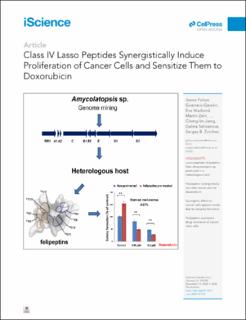| dc.contributor.author | Madland, Eva | |
| dc.contributor.author | Felipe Guerrero-Garzón, Jaime | |
| dc.contributor.author | Zehl, Martin | |
| dc.contributor.author | Singh, Madhurendra | |
| dc.contributor.author | Rezaei, Shiva | |
| dc.contributor.author | Aachmann, Finn Lillelund | |
| dc.contributor.author | Courtade, Gaston | |
| dc.contributor.author | Urban, Ernst | |
| dc.contributor.author | Rückert, Christian | |
| dc.contributor.author | Busche, Tobias | |
| dc.contributor.author | Kalinowski, Jörn | |
| dc.contributor.author | Cao, Yan-Ru | |
| dc.contributor.author | Jiang, Yi | |
| dc.contributor.author | Jiang, Cheng-lin | |
| dc.contributor.author | Selivanova, Galina | |
| dc.contributor.author | Zotchev, Sergey | |
| dc.date.accessioned | 2021-01-20T09:15:14Z | |
| dc.date.available | 2021-01-20T09:15:14Z | |
| dc.date.created | 2020-11-10T18:55:09Z | |
| dc.date.issued | 2020 | |
| dc.identifier.issn | 2589-0042 | |
| dc.identifier.uri | https://hdl.handle.net/11250/2723827 | |
| dc.description.abstract | Heterologous expression of a biosynthesis gene cluster from Amycolatopsis sp. resulted in the discovery of two unique class IV lasso peptides, felipeptins A1 and A2. A mixture of felipeptins stimulated proliferation of cancer cells, while having no such effect on the normal cells. Detailed investigation revealed, that pre-treatment of cancer cells with a mixture of felipeptins resulted in downregulation of the tumor suppressor Rb, making the cancer cells to proliferate faster. Pre-treatment with felipeptins made cancer cells considerably more sensitive to the anticancer agent doxorubicin and re-sensitized doxorubicin-resistant cells to this drug. Structural characterization and binding experiments showed an interaction between felipeptins resulting in complex formation, which explains their synergistic effect. This discovery may open an alternative avenue in cancer treatment, helping to eliminate quiescent cells that often lead to cancer relapse. | en_US |
| dc.language.iso | eng | en_US |
| dc.publisher | Cell Press | en_US |
| dc.rights | Attribution-NonCommercial-NoDerivatives 4.0 Internasjonal | * |
| dc.rights.uri | http://creativecommons.org/licenses/by-nc-nd/4.0/deed.no | * |
| dc.title | Class IV lasso peptides synergistically induce proliferation of cancer cells and sensitize them to doxorubicin | en_US |
| dc.type | Peer reviewed | en_US |
| dc.type | Journal article | en_US |
| dc.description.version | publishedVersion | en_US |
| dc.source.journal | iScience | en_US |
| dc.identifier.doi | 10.1016/j.isci.2020.101785 | |
| dc.identifier.cristin | 1846701 | |
| dc.relation.project | Norges forskningsråd: 226244 | en_US |
| dc.relation.project | Norges forskningsråd: 269408 | en_US |
| dc.description.localcode | This is an open access article under the CC BY-NC-ND license (http://creativecommons.org/licenses/by-nc-nd/4.0/) | en_US |
| cristin.ispublished | true | |
| cristin.fulltext | original | |
| cristin.qualitycode | 1 | |

